Flowers of the Happy Valley Forest
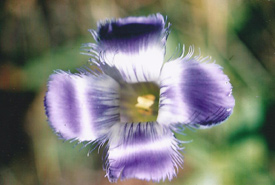
One of the most beautiful of Happy Valley blooms is the fringed gentian flower. (Photo by Dr. Henry Barnett)
The trees, flowers, ferns, birds and other animals of the Happy Valley Forest have been observed and catalogued over the past 60 years - altogether 200 species of plants have been identified growing on the floor of this forest located on the outskirts of Greater Toronto. The identification of these many collections has been made possible by many colleagues and experts, including John Riley and Mark Stabb of the Nature Conservancy of Canada.
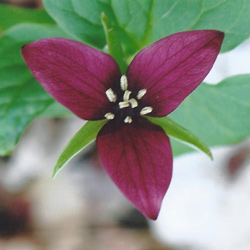
An eye-catching, scarlet red trillium with red petals and yellow stamens. (Photo by Dr. Henry Barnett)
Spring ephemerals
The flowers of the forest floor include the sudden burst of bloom that appears just after the snow melts. There are a number of species of plants like this that bloom early in the spring and do not blossom later into the summer; these are described as spring ephemerals. In late April and throughout May, the most important is the white trillium (the floral emblem of Ontario), which grows abundantly on the floor of the Happy Valley Forest. The red trillium, or wake-robin, is less common than the white and comes and disappears early. Another striking bloom, not a spring ephemeral but found in the fall, is the fringed gentian.
Trees that have particularly attractive spring flowers are the American beech, the red maple and a variety of apple frees. At least two species of hepatica bloom early (ranging from white to purple), distinguishable either by round or sharp lobed foliage. They are carefully watched for by my family as a sure sign of spring’s arrival. At the same time, bloodroot, languid lilly, dog tooth’s violet, merry-bells and deadly nightshade will appear throughout the forest, while columbine is common at the forest edge. None of these forest flowers come out after the dense foliage of the tall trees has appeared and blocked out the sunlight.
Orchids of the Happy Valley Forest
Whenever the forests of North America - including the Happy Valley Forest - become sufficiently wet and dense they will form an ideal part of the rainforest. The underlying soil in many places is largely peat moss, producing amphibian and aquatic forms of life. Orchids thrive in this medium as well.
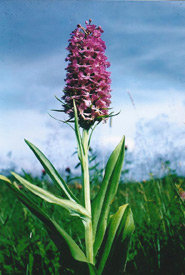
The large purple fringed orchid, one of the largest orchids in the Happy Valley Forest.(Photo by Dr. Henry Barnett)
The showy orchis and the showy red orchis (also known as showy lady slipper) occur in a few damp areas. Two species of ladies tresses are scattered, mostly at the forest’s edge. The yellow lady slipper occurs in higher ground, though it is becoming less common. It appears to be threatened by the recent abundance of white tailed deer, who favour the early spring shoots of this plant. Growing in moist areas is the splendid large purple fringed orchid. It is marginal in the edges of Happy Valley Forest, more common further to the north.
Mid-summer flowers
The striking Michigan lilly is a flower native to a large area of the continent. It blooms in late summer or early fall. Several varieties and sub-species exist, depending on their geographic location. These flowers look much alike and are strikingly beautiful, varying from deep orange to yellow. The bright yellow variety is sometimes known as the Canada lilly. The abundant “orange lilly” is more common in most Happy Valley Forest locations, especially roadside ditches, but it is often an introduced European variety that appears very similar to the Canadian variety known as turk’s-cap lilly.
Meadow flowers
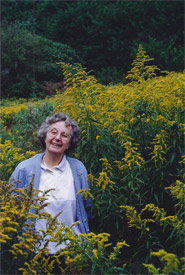
In wet seasons the common goldenrod may grow to be seven and eight feet tall. (Photo by Dr. Henry Barnett)
Flowers in open areas (meadows) are quite distinctive and abundant as a rule. Cleared areas are first invaded by the dandelion, and then fill up with the common Canada goldenrod. This growth will fill any valley. Some years with extra rainfall they may grow taller than a 6-foot person!
We cherish the common milkweed as it is the plant upon which the monarch butterfly subsists, has its eggs, and attaches its colourful cocoon. Farmers do not like it but they must tolerate it or they will pose another threat to the existence of this spectacular species of migratory butterfly who winter in a specific Mexican forest.
Other common meadow flowers are Queen Anne’s lace, with its flat-topped flower, and butter and eggs, chicory, New England aster and yarrow.
Carnivorous plants
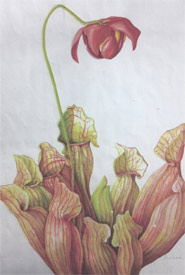
Plants eat animals! The Pitcher Plant is one of three carnivorous plants in the Happy Valley Forest. The tubular leaves are well represented in this painting by Ann Love.
Carnivorous plants are common in the edges of wet areas. The tallest of these is the pitcher plant, as depicted by this painting below. It only occurs at the margins of the Happy Valley Forest. The pitcher plant is the floral emblem of Newfoundland and Labrador. Carnivorous plants can snare, digest and incorporate many species of insects. Plants eat animals!
Marsh flowers
In addition to the ever-present marsh growths of reeds and cattails, there are distinctive wetland flowers, such as the Labrador tea. In early August clusters of yellow marsh marigold begin to brighten the swampy areas.
This is the third in a series of monthly blog posts Dr. Barnett will be contributing to Land Lines in the next few months.


